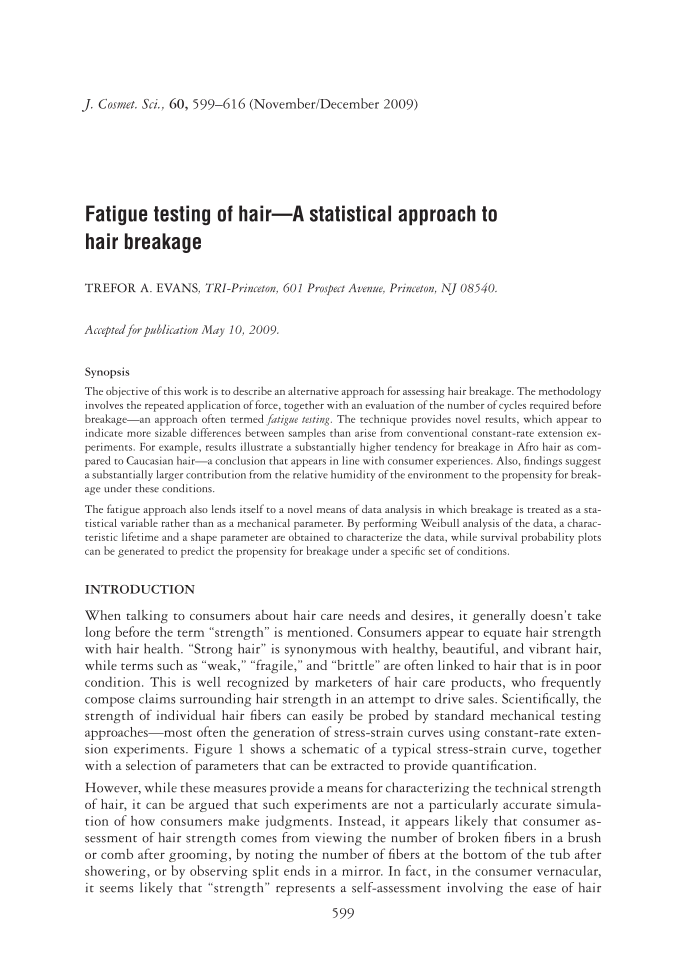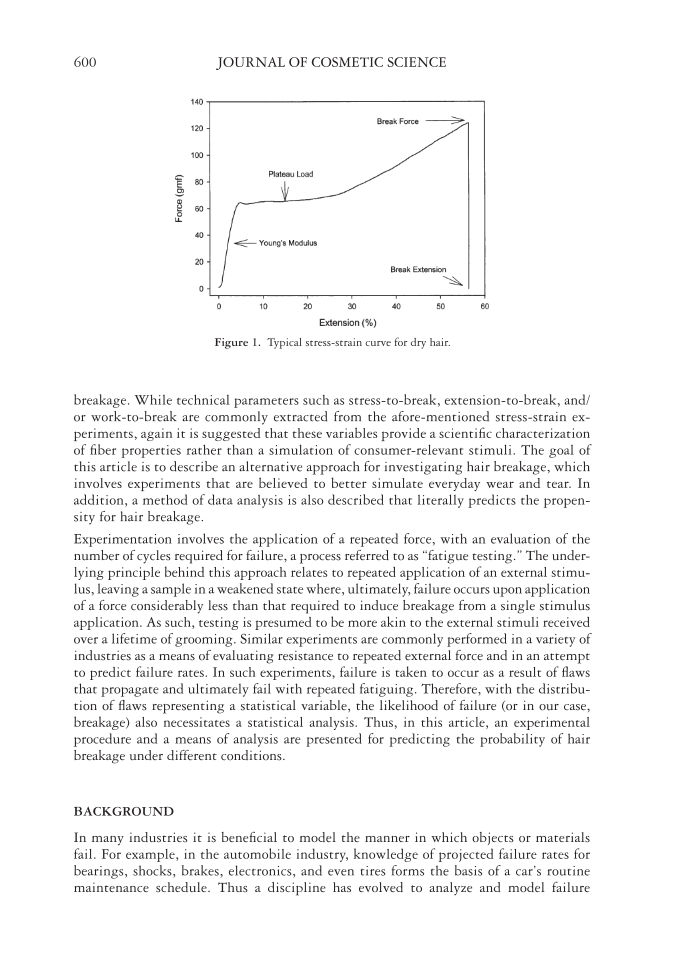J. Cosmet. Sci., 60, 599–616 (November/December 2009) 599 Fatigue testing of hair—A statistical approach to hair breakage TREFOR A. EVANS, TRI-Princeton, 601 Prospect Avenue, Princeton, NJ 08540. Accepted for publication May 10, 2009. Synopsis The objective of this work is to describe an alternative approach for assessing hair breakage. The methodology involves the repeated application of force, together with an evaluation of the number of cycles required before breakage—an approach often termed fatigue testing. The technique provides novel results, which appear to indicate more sizable differences between samples than arise from conventional constant-rate extension ex- periments. For example, results illustrate a substantially higher tendency for breakage in Afro hair as com- pared to Caucasian hair—a conclusion that appears in line with consumer experiences. Also, fi ndings suggest a substantially larger contribution from the relative humidity of the environment to the propensity for break- age under these conditions. The fatigue approach also lends itself to a novel means of data analysis in which breakage is treated as a sta- tistical variable rather than as a mechanical parameter. By performing Weibull analysis of the data, a charac- teristic lifetime and a shape parameter are obtained to characterize the data, while survival probability plots can be generated to predict the propensity for breakage under a specifi c set of conditions. INTRODUCTION When talking to consumers about hair care needs and desires, it generally doesn’t take long before the term “strength” is mentioned. Consumers appear to equate hair strength with hair health. “Strong hair” is synonymous with healthy, beautiful, and vibrant hair, while terms such as “weak,” “fragile,” and “brittle” are often linked to hair that is in poor condition. This is well recognized by marketers of hair care products, who frequently compose claims surrounding hair strength in an attempt to drive sales. Scientifi cally, the strength of individual hair fi bers can easily be probed by standard mechanical testing approaches—most often the generation of stress-strain curves using constant-rate exten- sion experiments. Figure 1 shows a schematic of a typical stress-strain curve, together with a selection of parameters that can be extracted to provide quantifi cation. However, while these measures provide a means for characterizing the technical strength of hair, it can be argued that such experiments are not a particularly accurate simula- tion of how consumers make judgments. Instead, it appears likely that consumer as- sessment of hair strength comes from viewing the number of broken fi bers in a brush or comb after grooming, by noting the number of fi bers at the bottom of the tub after showering, or by observing split ends in a mirror. In fact, in the consumer vernacular, it seems likely that “strength” represents a self-assessment involving the ease of hair
JOURNAL OF COSMETIC SCIENCE 600 breakage. While technical parameters such as stress-to-break, extension-to-break, and/ or work-to-break are commonly extracted from the afore-mentioned stress-strain ex- periments, again it is suggested that these variables provide a scientifi c characterization of fi ber properties rather than a simulation of consumer-relevant stimuli. The goal of this article is to describe an alternative approach for investigating hair breakage, which involves experiments that are believed to better simulate everyday wear and tear. In addition, a method of data analysis is also described that literally predicts the propen- sity for hair breakage. Experimentation involves the application of a repeated force, with an evaluation of the number of cycles required for failure, a process referred to as “fatigue testing.” The under- lying principle behind this approach relates to repeated application of an external stimu- lus, leaving a sample in a weakened state where, ultimately, failure occurs upon application of a force considerably less than that required to induce breakage from a single stimulus application. As such, testing is presumed to be more akin to the external stimuli received over a lifetime of grooming. Similar experiments are commonly performed in a variety of industries as a means of evaluating resistance to repeated external force and in an attempt to predict failure rates. In such experiments, failure is taken to occur as a result of fl aws that propagate and ultimately fail with repeated fatiguing. Therefore, with the distribu- tion of fl aws representing a statistical variable, the likelihood of failure (or in our case, breakage) also necessitates a statistical analysis. Thus, in this article, an experimental procedure and a means of analysis are presented for predicting the probability of hair breakage under different conditions. BACKGROUND In many industries it is benefi cial to model the manner in which objects or materials fail. For example, in the automobile industry, knowledge of projected failure rates for bearings, shocks, brakes, electronics, and even tires forms the basis of a car’s routine maintenance schedule. Thus a discipline has evolved to analyze and model failure Figure 1. Typical stress-strain curve for dry hair.
Purchased for the exclusive use of nofirst nolast (unknown) From: SCC Media Library & Resource Center (library.scconline.org)

































































































